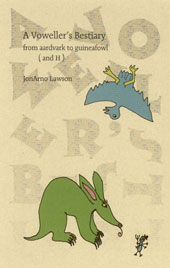The Porcupine's Quill
Celebrating forty years on the Main Street
of Erin Village, Wellington County
BOOKS IN PRINT
A Voweller's Bestiary by JonArno Lawson
[ Lipogram: a composition from which the writer rejects all words that contain a certain letter or letters. ]
JonArno Lawson, addict of wordplay and lover of children’s poetry, has created a collection of lipograms written for children. The idea behind A Voweller’s Bestiary is a simple one: an alphabet book based on vowel combinations, rather than on initial letters. This is vowel language applied to the animal kingdom.
An exquisite use of, and exploration of language, JonArno Lawson’s A Voweller’s Bestiary, is a lipogram in fine form. This book offers a fanciful look into the animal kingdom. The wonderful use of language, and exploration of the animal kingdom are sure to make this a children’s favourite. An alphabet book in a non-traditional sense (by making use of vowel combinations, rather than focusing on initial letters), Lawson demonstrates for children, and readers of all ages, the depth, fun and excitement to be found in language.

2008—IPPY Moonbeam Award,
Shortlisted

2009—ForeWord Magazine Book of the Year,
Shortlisted

2009—The Lion and the Unicorn Award,
Winner
Review quote
‘The reader will first be amused by the images and rhythms of the poems in this book and delighted with its focus on animals. Deeper pleasure awaits, though, in noting Lawson’s careful selection of words. As he explains in his afterword, his intention was to create an ‘‘alphabet book based on vowel combinations, rather than initial letters,’’ but that was only the beginning. The poems combine extraordinary skill with language along a great imagination and sense of humor. The collection is sure to delight children and adults on several levels.’
Review quote
‘Crafting exquisite verse for children using the themes of the alphabet and the animal kingdom, A Voweller’s Bestiary is sure to entertain, educate, and please child readers. Highly recommended for community library poetry collections.’
—Midwest Book Review
Review quote
‘Taking cues from Dr. Seuss, Richard Wilbur, bp Nichol, Christian Bok and others, JonArno Lawson offers a book for children (and their adults) based on a love of wordplay and the self-imposed restrictions of the lipogram -- words and sentences using only a limited set of vowels.
‘A Voweller’s Bestiary is an alphabet book based on vowel combinatiuons, rather than initial letters.
Consider:
Iguana burial rituals
Languish,
Causing iguanas
Spiritual anguish.
Or:
Aloof racoons gambol across woodlands
Accost stoats, goad toads
Loaf among oaks, swallow acorns,
Also oats.
Wanton racoon oafs, amok
Adopt gloam’s cloak:
Roam along
Afloat almost.
‘Add to these lighthearted poems Lawson’s charming illustrations and you have a book that will delight children as it teaches them about the sounds of language.’
—Paul Baker, WordSalad
Review quote
‘This is a children’s book, and I don’t know from children. The vocabulary is recondite, perhaps because of the constraint, perhaps because the author isn’t interested in dumbing it down for kids, perhaps because he trusts that the sheer fun of the sounds and the wordplay will entertain kids during passages where the grammar is so torqued or the words so obscure that they will have a hard time parsing it. Or perhaps this is a children’s book for adults, for those of us who are unafraid of the arbitrary marking of wordplay as childish, who like to exercise our tongues and our minds with the material of language, and whose imaginations, such as they are, tend towards making everything cartoonish and violent. And for those of us who enjoy simple and cute line art, or good ‘‘macaque’’ jokes. But will this book make a good Christmas present for an eight-year-old boy? Those of you with such children in your life, please, go out, get this book, read it to them, and report back to me, ideally in time for my holiday shopping.’
—Chris Piuma, Agora
Review quote
‘Lawson’s wordplay exactly achieves his intent. He makes us pay attention to words as words, to letters as letters, the miracle that is communication from the smallest scratches on the page to the biggest ideas we can muster. He also makes us puzzle through a series of rich, eccentric juxtapositions, to practise in our minds that very ‘‘lively rigour’’ hailed by the Lion and the Unicorn jury.’
—Deirdre Baker, Toronto Star
Author comments
I’ve worked on this book guiltily for several years. My troubled conscience (I have two children; economic imperatives are always asserting themselves) has worked on a justification for the book as long as I’ve worked on the book itself, which I offer below.
Others have played beyond the restrictions of the A-is for Apple, B-is for Bee type of alphabet book before -- one of the most memorable being Dr. Seuss with his brilliant On beyond Zebra!, another being Richard Wilbur’s The Disappearing Alphabet. While the work of bpNichol has been indispensable in pointing me in this direction, and Christian Bök’s Eunoia was a direct inspiration, a short quote from David Pendlebury’s afterword to his abridged translation of Hakim Sanai’s Walled Garden of Truth (The Octagon Press, London, 1974) underscores the reason why I wished to attempt something in this form:
‘This is perhaps a good moment to question the assumption that because in our culture the fascination of secret codes, rhyming, punning, spoonerisms, etc., tends to wane with the onset of puberty, such activities are inherently childish and immature. Indeed when we find a culture, like Sanai’s [12th century Ghaznavid Persian], in which these preoccupations persist, in correspondingly more sophisticated forms, right into adult life, we may even begin to wonder why this capacity seems to atrophy so soon in the West. Far from having outgrown an infantile mode of behaviour, it may be argued that we have failed to develop its potential adult stage -- a very valuable counterweight to the hypnotic power of linear verbal communication. Naturally our thinkers write and speak words -- and yet everything is ruthlessly excluded from their communications which might serve to remind us that what is actually being communicated is not thought, but mere words. Language has become for us like water: a tasteless, odourless, colourless medium; and like fish we are only aware of its existence when for some reason we are suddenly deprived of it. We are effectively anaesthetized to words; and perhaps precisely for that very reason we have been more enslaved by them than any other culture in history.’
Oddly, while some of these concerns have been addressed in adult poetry in the thirty years following the publication of Pendlebury’s afterword, it’s less and less a part of the poetry published for children.
Addict of wordplay and lover of children’s poetry that I am, it seemed a shame to me that there wasn’t a collection of lipograms anywhere written for children in particular. Few, aside from Ross Eckler’s amazing lipogrammatic variations on ‘Mary had a little lamb’, seemed to have been written within hearing of children, and I wanted to help remedy this.
It interested me how etymologically unrelated synonyms and antonyms often shared exactly the same vowels (Magician/wizard; happy/angry, eavesdrop/overhear; companionable/cooperative/hospitable, etc.). (Less interesting to me was the fact that they often don’t ...).
The idea behind A Voweller’s Bestiary is a simple one; an alphabet book based on vowel combinations, rather than on initial letters. I used the lipogrammatic rule of excluding certain vowels from each set (the sets being a, e, i, o, u, ae, ai, ao, au, ei, eo, eu, io, iu, ou, aei, aeo, aeu, aio, oiu, aou, eio, eiu, eou, iou, aeio, aeiu, aiou, eiou, aeou, aeiou, y).
BUT -- I also followed my own extra rule of including each of the included vowels in each word. I don’t think anyone has ever come at it this way before. If you know of someone who has, please resist the urge to inform me; I’d rather that you not spoil my happy illusion of having done something a little bit original.
The little H section at the end was simply to play about with H’s strange transformative function when it falls after certain letters. David Sacks has written a marvelous book called Language Visible, Unraveling the mystery of the alphabet from A to Z which has a fascinating discussion of the history of the letter H (and of all of the other letters as well).
You may notice that Y is used once as a consonant, but I excluded it as a vowel, except in the poem ‘Fly, lynx’. It’s possible, at a stretch, to make lines for the ‘AY’ (angry jays play abysmally)‘EY’ (veery, they’re everywhere, veery eye prey), ‘IY’ (silly grizzly bicycling timidly) ‘OY’, (Booby’s nobody’s boy), ‘UY’ (Hurry furry husky puppy!) or even ‘OEY’ sets, but I couldn’t find enough matching animals or words (OEY was almost Osprey or Donkey -- but I couldn’t get much further than ‘Osprey enjoys donkey’s tomfoolery’, or ‘Monkey’s poetry destroys osprey’s decoy ceremony’).
In any case, my real hope with this strange little book is that someone reading it will say, ‘Wait, I have a better idea ...’ and will take the time to make something of it.
Unpublished endorsement
‘Good golly gosh! Go gobble book! Got lots of raccoons, moose, loons, but -- oh -- look, no lox! Yoo-hoo! Moo for word zoo!’
—Charles Bernstein
Unpublished endorsement
‘Readers will rejoice in JonArno’s clever use of vowel language (not restricted to four-letter words) which surveys the animal kingdom. The following CATerwaul in DOGgerel should offer a clue as to what is going on:
In JonArno’s zoo the duck joins the gnu,
The raccoon shares its cage with a stoat,
Beaver and hare make a wonderful pair,
And the lizard and snail aren’t remote.’
—Ross Eckler
Unpublished endorsement
‘Really, Voweller’s is a virtuoso performance.’
—Joseph Thomas
Born in Hamilton, Ontario and raised nearby in Dundas, JonArno Lawson is a four-time winner of the Lion and the Unicorn Award for Excellence in North American Children’s Poetry, for Black Stars in a White Night Sky in 2007, in 2009 for A Voweller’s Bestiary, in 2013 for Down in the Bottom of the Bottom of the Box and again in 2014 for Enjoy It While It Hurts. In 2011 his poetry collection Think Again was short-listed for the Ruth and Sylvia Schwartz Children’s Book Award. Sidewalk Flowers won the Governor General’s Award for Illustrated Children’s Books in 2015. JonArno lives in Toronto with his wife Amy Freedman and his children Sophie, Ashey and Joseph, all of whom assist the author with phrases, topics and sometimes even complete lines for use in his poems.
The Porcupine's Quill would like to acknowledge the support of the Ontario Arts Council and the Canada Council for the Arts for our publishing program. The financial support of the Government of Canada through the Canada Book Fund (CBF) is also gratefully acknowledged.




